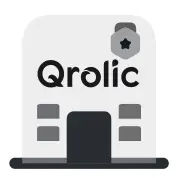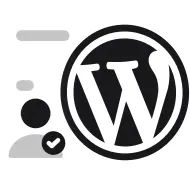Quick Summary:
- Showcase artist work with stunning portfolios.
- Offer convenient online booking for clients.
- Provide clear pricing and service information.
- Ensure your website is mobile-friendly and secure.
Table of Contents
- The Indelible First Impression: Why Your Tattoo Studio Website Matters
- Core Website Features That Can Transform Your Business
- 1. Stunning Artist Portfolios: Showcasing the Ink Masters
- 2. Online Appointment Booking: Streamlining the Client Experience
- 3. Clear Pricing and Services Information: Transparency Builds Trust
- 4. Compelling “About Us” Page: Telling Your Story
- 5. Contact Information and Location: Making it Easy to Connect
- 6. Blog and News Section: Engaging Your Audience and Boosting SEO
- 7. Social Media Integration: Expanding Your Reach
- 8. Mobile Responsiveness: Reaching Clients on the Go
- 9. Security (SSL Certificate): Protecting Your Clients’ Data
- 10. Fast Loading Speed: Keeping Visitors Engaged
- Elevating Your Website: Advanced Features to Stand Out
- The Importance of SEO (Search Engine Optimization) for Tattoo Studios
- Qrolic Technologies: Your Partner in Building a Killer Tattoo Studio Website
- Measuring Success: Website Analytics and Key Performance Indicators (KPIs)
- The Future of Tattoo Studio Websites: Trends to Watch
- Conclusion: Invest in Your Digital Canvas
The Indelible First Impression: Why Your Tattoo Studio Website Matters
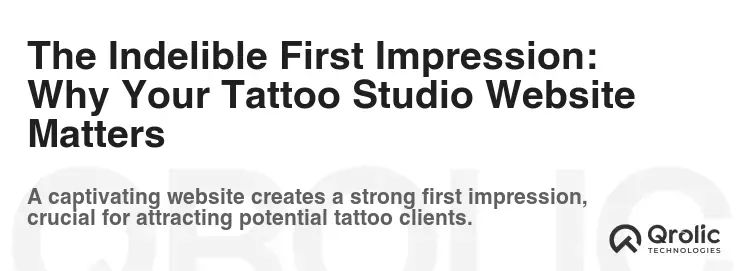
Your tattoo studio is more than just a place to get inked; it’s a canvas, a haven, a testament to artistry and self-expression. In the digital age, your website is the first impression many potential clients will have. It’s your digital storefront, your 24/7 ambassador, and a crucial tool for attracting new business and building a loyal following. A poorly designed or outdated website can be a significant deterrent, leading potential clients to seek out studios with a more polished and professional online presence.
But what exactly makes a good tattoo studio website? It’s not just about flashy graphics and cool fonts (although aesthetics do matter!). It’s about providing a seamless, informative, and engaging experience that reflects the artistry and professionalism of your studio. It’s about turning online visitors into paying clients.
Core Website Features That Can Transform Your Business
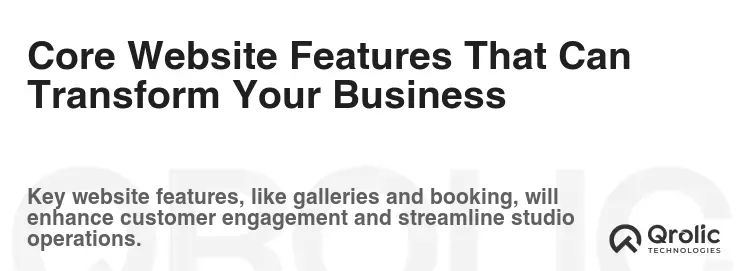
Here’s a breakdown of the essential website features that every successful tattoo studio needs to implement:
1. Stunning Artist Portfolios: Showcasing the Ink Masters
- Why it matters: Your artists are your greatest asset. Potential clients choose a studio based on the quality and style of the artists’ work. The artist portfolio is the single most important element of your website. This is where you showcase your talent and attract clients who resonate with specific artistic styles.
- What to include:
- High-Quality Images: Invest in professional photography! Fuzzy or poorly lit photos won’t cut it. Every piece should be crisp, clear, and accurately represent the artist’s skill. Capture the vibrancy of colors, the precision of lines, and the overall artistry of the tattoo.
- Detailed Descriptions: Don’t just show the tattoo; tell the story. Include information about the inspiration behind the piece, the techniques used, and the client’s experience. This adds depth and personality to the portfolio.
- Artist Biographies: Introduce each artist with a compelling biography. Highlight their background, experience, specialties, and artistic philosophy. This helps clients connect with the artists on a personal level.
- Categorization and Filtering: Allow visitors to easily filter the portfolio by artist, style (e.g., traditional, realism, watercolor), body placement (e.g., sleeve, back, leg), or other relevant categories. This makes it easy for potential clients to find exactly what they’re looking for.
- Before & After Photos (Optional): For cover-ups or significant transformations, showing before-and-after photos can be incredibly powerful.
- Watermarks (Subtle): Protect your artists’ work by adding subtle watermarks to prevent unauthorized use.
- Mobile Optimization: Ensure the portfolio looks stunning on all devices, especially mobile phones. Most users will view your website on their phones.
- SEO Benefits: Optimize image file names with relevant keywords (e.g., “traditional-tattoo-sleeve-rose.jpg”). Use alt text to describe each image, further enhancing SEO.
- Examples:
- A dedicated page for each artist with their biography and portfolio.
- A gallery showcasing different tattoo styles (e.g., black and gray, color, geometric).
- A filter that allows users to search for tattoos by body part.
- Key Takeaway: The artist portfolio is the heart of your website. Make it visually appealing, informative, and easy to navigate.
2. Online Appointment Booking: Streamlining the Client Experience
- Why it matters: In today’s fast-paced world, convenience is king. Online appointment booking allows clients to schedule appointments 24/7, without having to call or email. This streamlines the booking process, reduces administrative overhead, and improves the overall client experience.
- What to include:
- Real-Time Availability: Display real-time artist availability, allowing clients to see when they can book their appointment.
- Service Selection: Allow clients to select the type of service they need (e.g., consultation, small tattoo, large tattoo, cover-up).
- Artist Selection: Let clients choose their preferred artist (if they have one).
- Date and Time Selection: Provide a user-friendly calendar interface for selecting the date and time of the appointment.
- Automatic Reminders: Send automatic appointment reminders via email or SMS to reduce no-shows.
- Deposit Collection: Integrate with a payment gateway to collect deposits online, securing the appointment and reducing the risk of cancellations.
- Integration with Calendar: Sync the booking system with your studio’s calendar (e.g., Google Calendar, Outlook Calendar) to avoid double-booking.
- Confirmation Emails: Send automatic confirmation emails to clients after they book their appointment.
- Mobile Responsiveness: Ensure the booking system works seamlessly on all devices.
- Benefits:
- Increased Bookings: Make it easier for clients to book appointments, leading to more bookings.
- Reduced No-Shows: Automatic reminders reduce the number of no-shows.
- Improved Efficiency: Streamline the booking process and reduce administrative overhead.
- Enhanced Client Experience: Provide a convenient and user-friendly booking experience.
- Examples:
- A simple booking form embedded on the website.
- Integration with a third-party booking platform (e.g., Acuity Scheduling, Square Appointments).
- A dedicated booking page with clear instructions.
- Key Takeaway: Online appointment booking is a must-have for any modern tattoo studio. It improves efficiency, enhances the client experience, and ultimately leads to more business.
3. Clear Pricing and Services Information: Transparency Builds Trust
- Why it matters: Clients want to know what to expect in terms of pricing and services. Providing clear and transparent information builds trust and reduces the likelihood of misunderstandings.
- What to include:
- Detailed Service Descriptions: Clearly describe each service you offer, including what’s included and what’s not.
- Pricing Guidelines: Provide general pricing guidelines for different types of tattoos. Be transparent about your hourly rates, minimum charges, and any additional fees.
- Consultation Information: Explain the consultation process and any associated fees.
- Aftercare Instructions: Provide detailed aftercare instructions to help clients properly care for their new tattoos.
- Payment Options: Clearly list the payment options you accept (e.g., cash, credit card, debit card, online payment).
- Policies: Outline your studio’s policies regarding cancellations, rescheduling, and refunds.
- Benefits:
- Reduced Inquiries: Answer common questions upfront, reducing the number of inquiries you receive.
- Increased Transparency: Build trust with potential clients by being transparent about your pricing and services.
- Improved Client Satisfaction: Set clear expectations and avoid misunderstandings.
- Examples:
- A dedicated “Services” page with detailed descriptions and pricing guidelines.
- A FAQ section addressing common questions about pricing and services.
- A downloadable aftercare instruction sheet.
- Key Takeaway: Transparency is key to building trust and attracting clients. Provide clear and comprehensive information about your pricing and services.
4. Compelling “About Us” Page: Telling Your Story
- Why it matters: The “About Us” page is your opportunity to connect with potential clients on a personal level. It’s where you tell your story, showcase your values, and build trust.
- What to include:
- Studio History: Share the story of how your studio came to be.
- Mission Statement: Articulate your studio’s mission and values.
- Artist Introductions: Provide detailed biographies of each artist, highlighting their experience, specialties, and artistic philosophy.
- Studio Photos: Include photos of your studio, showcasing its atmosphere and cleanliness.
- Testimonials: Feature testimonials from satisfied clients.
- Awards and Recognition: Highlight any awards or recognition your studio has received.
- Community Involvement: Share information about your involvement in the local community.
- Benefits:
- Builds Trust: Connect with potential clients on a personal level.
- Showcases Your Values: Communicate your studio’s mission and values.
- Attracts Like-Minded Clients: Appeal to clients who share your values and artistic vision.
- Examples:
- A timeline of your studio’s history.
- A video showcasing your studio and artists.
- Quotes from your artists about their passion for tattooing.
- Key Takeaway: The “About Us” page is your opportunity to tell your story and connect with potential clients on a personal level. Make it personal, engaging, and informative.
5. Contact Information and Location: Making it Easy to Connect
- Why it matters: It should be incredibly easy for potential clients to contact you and find your studio. Clear and prominent contact information is essential.
- What to include:
- Phone Number: Display your phone number prominently on every page of your website.
- Email Address: Provide a contact form and/or a direct email address.
- Studio Address: Clearly display your studio address, including the street address, city, state, and zip code.
- Map Integration: Embed a Google Map showing your studio’s location.
- Hours of Operation: Clearly state your studio’s hours of operation.
- Social Media Links: Include links to your social media profiles (e.g., Instagram, Facebook).
- Benefits:
- Increased Inquiries: Make it easy for potential clients to contact you with questions or inquiries.
- Improved Accessibility: Help clients easily find your studio.
- Enhanced Customer Service: Provide prompt and helpful responses to inquiries.
- Examples:
- A contact form on your website.
- A Google Map embedded on your “Contact Us” page.
- A sticky footer with your phone number and email address.
- Key Takeaway: Make it as easy as possible for potential clients to contact you and find your studio.
6. Blog and News Section: Engaging Your Audience and Boosting SEO
- Why it matters: A blog and news section allows you to share valuable content with your audience, establish yourself as an authority in the tattoo industry, and improve your website’s SEO.
- What to include:
- Informative Articles: Write articles about tattoo styles, aftercare, tattoo history, artist interviews, and other topics of interest to your target audience.
- News and Updates: Share news about your studio, such as new artists, promotions, events, and community involvement.
- High-Quality Images and Videos: Use visually appealing images and videos to enhance your content.
- Call to Action: Include a call to action in each blog post, encouraging readers to book an appointment, contact you, or learn more.
- SEO Optimization: Optimize your blog posts for relevant keywords to improve your search engine ranking.
- Social Sharing Buttons: Make it easy for readers to share your blog posts on social media.
- Benefits:
- Improved SEO: Attract more organic traffic to your website.
- Increased Engagement: Keep your audience engaged and coming back for more.
- Established Authority: Position yourself as an expert in the tattoo industry.
- Lead Generation: Generate leads by providing valuable content and a call to action.
- Examples:
- “The Ultimate Guide to Tattoo Aftercare”
- “Meet Our New Artist: [Artist Name]”
- “Top 10 Tattoo Styles of 2024”
- Key Takeaway: A blog and news section is a powerful tool for engaging your audience, establishing authority, and improving your website’s SEO.
7. Social Media Integration: Expanding Your Reach
- Why it matters: Social media is a powerful tool for promoting your tattoo studio and connecting with potential clients. Integrating your social media accounts into your website makes it easy for visitors to follow you and stay up-to-date on your latest work.
- What to include:
- Social Media Icons: Display social media icons prominently on your website, linking to your profiles.
- Social Media Feed: Embed your social media feed on your website, showcasing your latest posts.
- Social Sharing Buttons: Make it easy for visitors to share your content on social media.
- Follow Buttons: Encourage visitors to follow you on social media.
- Benefits:
- Increased Social Media Followers: Drive traffic to your social media profiles.
- Enhanced Engagement: Keep your audience engaged and connected.
- Expanded Reach: Reach a wider audience through social media.
- Examples:
- An Instagram feed embedded on your homepage.
- Social sharing buttons on your blog posts.
- A pop-up asking visitors to follow you on Instagram.
- Key Takeaway: Social media integration is essential for expanding your reach and connecting with potential clients.
8. Mobile Responsiveness: Reaching Clients on the Go
- Why it matters: The majority of website traffic now comes from mobile devices. A website that is not mobile-responsive will provide a poor user experience and can negatively impact your search engine ranking.
- What to do:
- Use a Responsive Design Framework: Choose a website theme or framework that is designed to be mobile-responsive.
- Test Your Website on Different Devices: Test your website on different mobile devices and screen sizes to ensure it looks and functions properly.
- Optimize Images for Mobile: Optimize images for mobile devices to reduce loading times.
- Use a Mobile-Friendly Navigation Menu: Use a navigation menu that is easy to use on mobile devices.
- Benefits:
- Improved User Experience: Provide a seamless user experience on all devices.
- Increased Engagement: Keep visitors engaged and on your website longer.
- Improved SEO: Improve your search engine ranking.
- Key Takeaway: Mobile responsiveness is no longer optional; it’s essential.
9. Security (SSL Certificate): Protecting Your Clients’ Data
- Why it matters: An SSL certificate encrypts the data transmitted between your website and your visitors, protecting their personal information. This is especially important if you collect any sensitive information, such as credit card numbers or personal contact details.
- What to do:
- Obtain an SSL Certificate: Purchase an SSL certificate from a reputable provider.
- Install the SSL Certificate: Install the SSL certificate on your web server.
- Ensure Your Website Uses HTTPS: Make sure your website uses HTTPS (Hypertext Transfer Protocol Secure) instead of HTTP.
- Benefits:
- Increased Security: Protect your clients’ data from hackers.
- Improved Trust: Build trust with potential clients by showing that you take security seriously.
- Improved SEO: Google favors websites that use HTTPS.
- Key Takeaway: Security is paramount. An SSL certificate is a must-have for any website that collects personal information.
10. Fast Loading Speed: Keeping Visitors Engaged
- Why it matters: Website loading speed is a critical factor in user experience and SEO. Visitors are likely to abandon a website that takes too long to load.
- What to do:
- Optimize Images: Compress images to reduce file sizes.
- Use a Content Delivery Network (CDN): Use a CDN to distribute your website’s content across multiple servers, improving loading speeds for users around the world.
- Minimize HTTP Requests: Reduce the number of HTTP requests your website makes.
- Enable Browser Caching: Enable browser caching to allow visitors’ browsers to store static content, reducing loading times on subsequent visits.
- Choose a Fast Web Hosting Provider: Choose a web hosting provider with fast servers and reliable uptime.
- Benefits:
- Improved User Experience: Keep visitors engaged and on your website longer.
- Lower Bounce Rate: Reduce the number of visitors who abandon your website.
- Improved SEO: Google favors websites with fast loading speeds.
- Key Takeaway: Website loading speed is critical for user experience and SEO. Optimize your website for speed to keep visitors engaged.
Elevating Your Website: Advanced Features to Stand Out
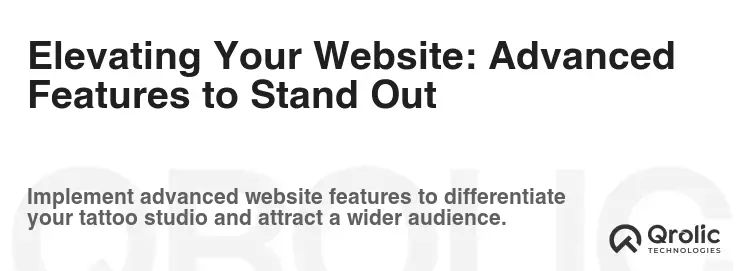
Once you’ve implemented the core features, consider these advanced features to further enhance your website and differentiate yourself from the competition:
- Virtual Consultations: Offer virtual consultations via video conferencing to connect with clients remotely.
- Online Merchandise Store: Sell tattoo-related merchandise, such as clothing, art prints, and aftercare products.
- Language Translation: Offer your website in multiple languages to cater to a wider audience.
- Custom Tattoo Design Tool: Allow clients to design their own tattoos online.
- Interactive Tattoo Placement Tool: Allow clients to visualize how a tattoo will look on different parts of their body.
- Live Chat Support: Provide live chat support to answer client questions in real-time.
- 360° Studio Tour: Offer a virtual tour of your studio to showcase its atmosphere and cleanliness.
The Importance of SEO (Search Engine Optimization) for Tattoo Studios
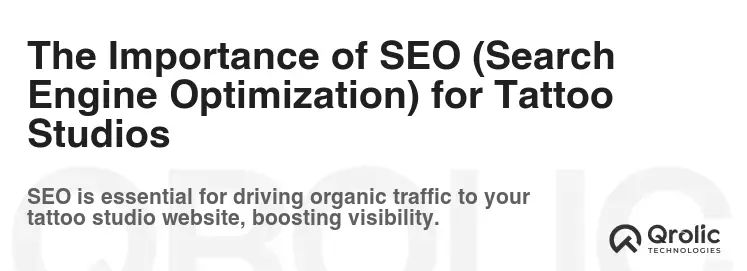
Creating a beautiful and functional website is only half the battle. You also need to ensure that potential clients can find your website in search engine results. This is where SEO comes in.
SEO is the process of optimizing your website to rank higher in search engine results pages (SERPs). A higher ranking means more visibility, more traffic, and ultimately, more clients.
Here are some key SEO strategies for tattoo studios:
- Keyword Research: Identify the keywords that potential clients are using to search for tattoo studios in your area.
- On-Page Optimization: Optimize your website’s content and structure for relevant keywords. This includes using keywords in your page titles, headings, meta descriptions, and body text.
- Local SEO: Optimize your website for local search. This includes creating a Google My Business listing, claiming your business on online directories, and encouraging clients to leave reviews.
- Link Building: Build high-quality backlinks from other websites to your website. This helps to improve your website’s authority and ranking.
- Content Marketing: Create valuable and informative content that attracts and engages potential clients. This can include blog posts, articles, videos, and infographics.
Qrolic Technologies: Your Partner in Building a Killer Tattoo Studio Website
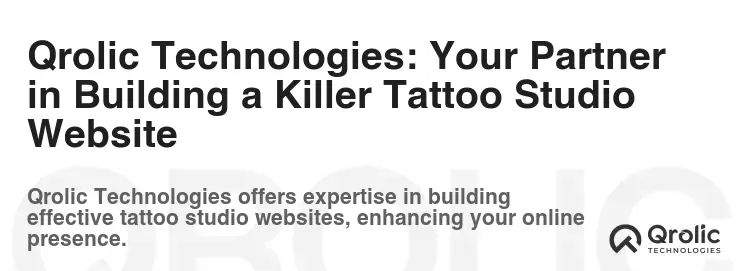
At Qrolic Technologies (https://qrolic.com/), we understand the unique needs of tattoo studios and are passionate about helping you create a website that reflects your artistry and drives business growth. We offer a range of services, including:
- Website Design and Development: We create custom websites that are visually stunning, user-friendly, and optimized for SEO.
- Online Booking System Integration: We seamlessly integrate online booking systems into your website, streamlining the booking process and reducing administrative overhead.
- SEO Services: We help you improve your website’s search engine ranking and attract more organic traffic.
- Social Media Marketing: We help you build a strong social media presence and connect with potential clients.
- Content Marketing: We create valuable and informative content that attracts and engages your target audience.
We work closely with our clients to understand their specific needs and goals and develop a customized strategy to help them achieve success online. Contact us today to learn more about how we can help you build a killer tattoo studio website.
Measuring Success: Website Analytics and Key Performance Indicators (KPIs)
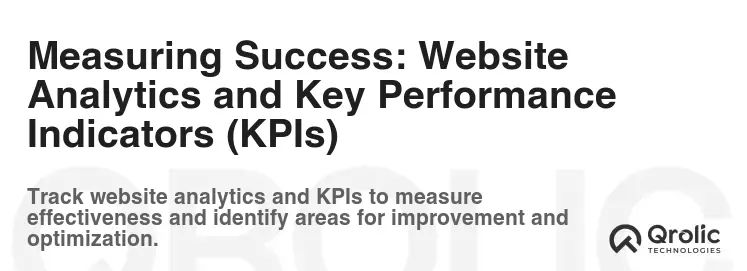
Once your website is live, it’s important to track its performance and measure its success. This is where website analytics comes in.
Website analytics tools, such as Google Analytics, provide valuable data about your website traffic, user behavior, and conversions. By tracking key performance indicators (KPIs), you can identify areas for improvement and optimize your website to achieve your business goals.
Here are some important KPIs to track for your tattoo studio website:
- Website Traffic: Track the number of visitors to your website.
- Bounce Rate: Track the percentage of visitors who leave your website after viewing only one page.
- Time on Site: Track the average amount of time visitors spend on your website.
- Conversion Rate: Track the percentage of visitors who complete a desired action, such as booking an appointment or contacting you.
- Leads Generated: Track the number of leads generated from your website.
- Sales Generated: Track the amount of revenue generated from your website.
By monitoring these KPIs, you can gain valuable insights into your website’s performance and make data-driven decisions to improve its effectiveness.
The Future of Tattoo Studio Websites: Trends to Watch
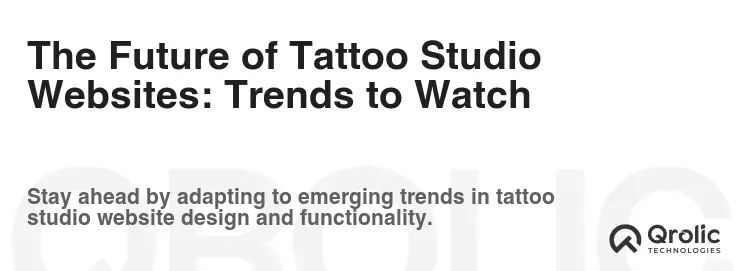
The world of web design and technology is constantly evolving. Here are some trends to watch in the future of tattoo studio websites:
- Artificial Intelligence (AI): AI-powered chatbots and virtual assistants will become increasingly common, providing personalized support and answering client questions in real-time.
- Augmented Reality (AR): AR technology will allow clients to visualize how a tattoo will look on their body before getting inked.
- Personalized Experiences: Websites will become more personalized, tailoring content and offers to individual users based on their preferences and behavior.
- Voice Search Optimization: Websites will need to be optimized for voice search to cater to the growing number of users who use voice assistants like Siri and Google Assistant.
- Accessibility: Websites will need to be accessible to people with disabilities, ensuring that everyone can access and use your website.
By staying up-to-date on these trends, you can ensure that your website remains cutting-edge and continues to attract and engage potential clients.
Conclusion: Invest in Your Digital Canvas
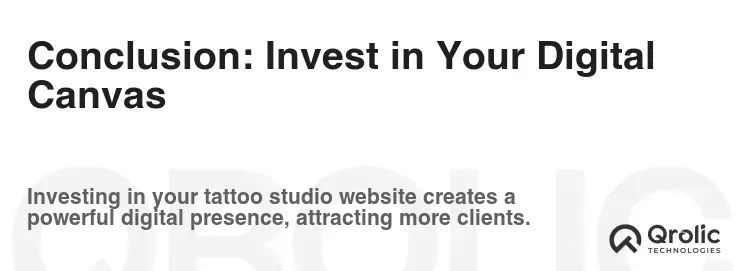
Your tattoo studio website is more than just a digital brochure; it’s a powerful marketing tool that can attract new clients, build brand loyalty, and drive business growth. By implementing the features and strategies outlined in this article, you can create a website that reflects your artistry, enhances the client experience, and helps you achieve success in the competitive tattoo industry. So, invest in your digital canvas and watch your business thrive.




